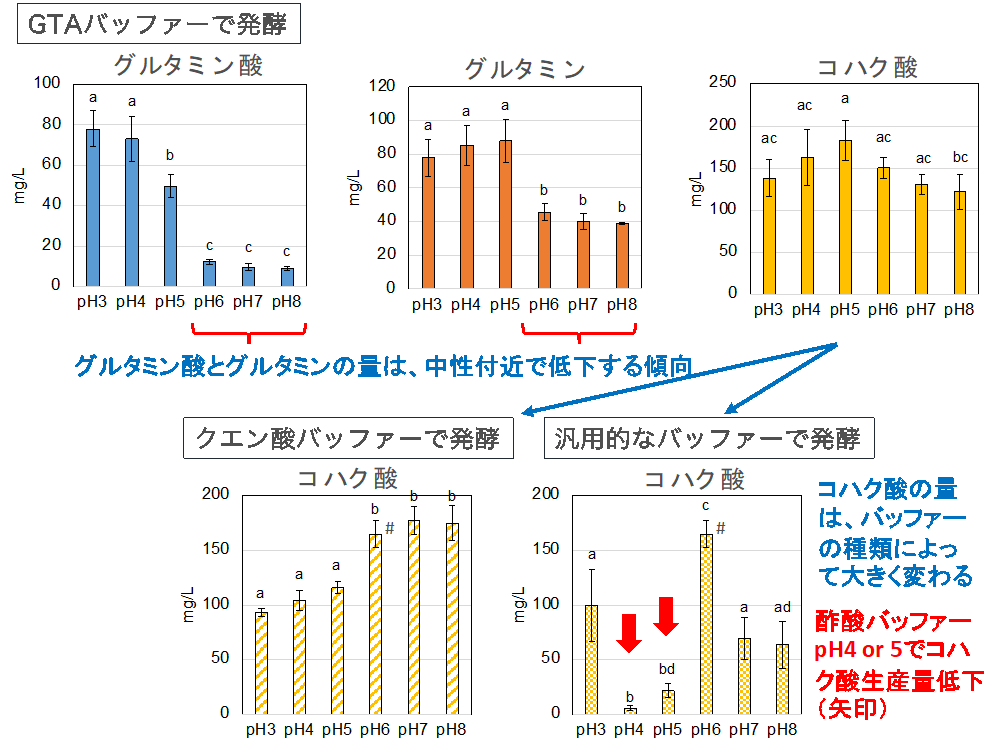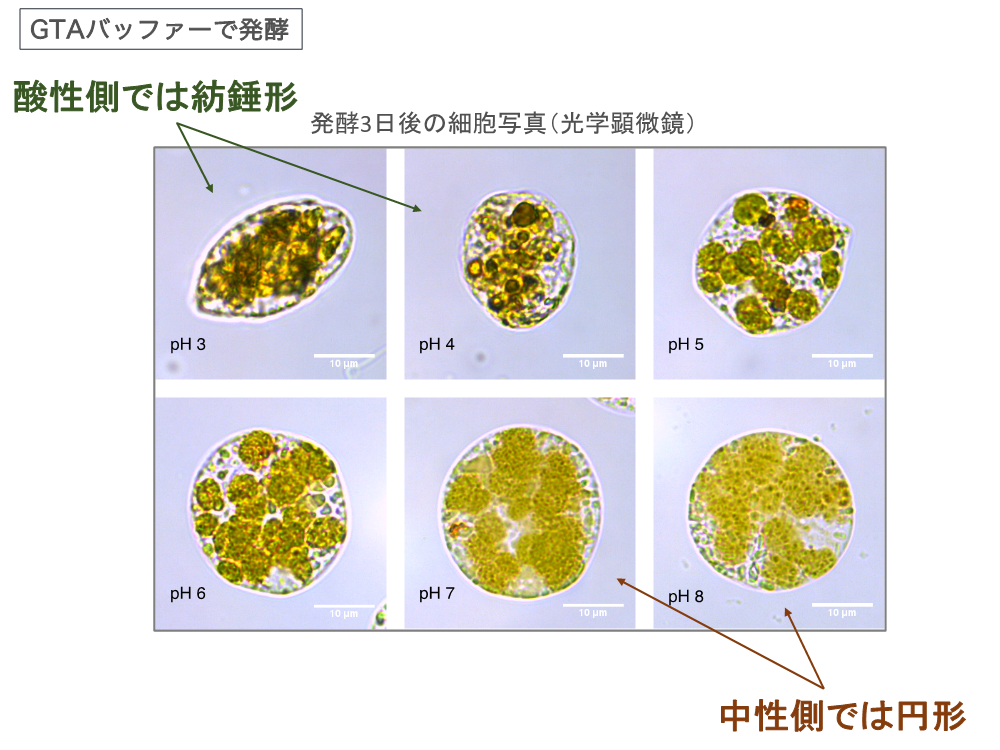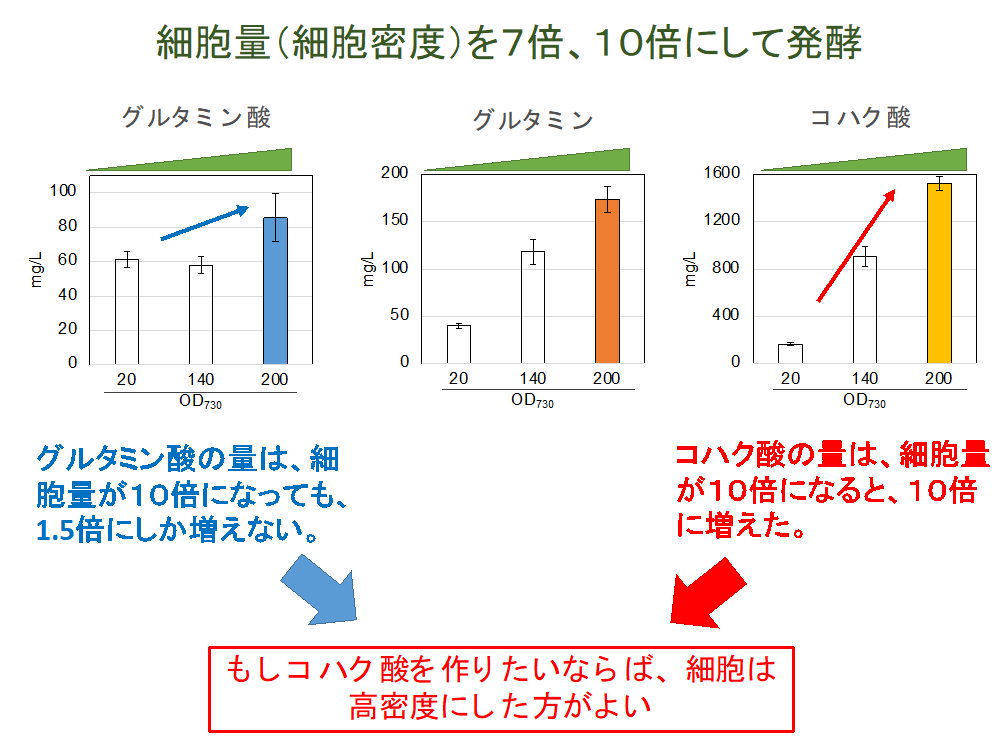Press Releases
* Please note that the news release contains the content at the time of the announcement and may differ from the latest information.
Euglena 's amino acid and organic acid fermentation
~ Euglena changes its shape depending on the pH at the time of fermentation ~
Meiji University
RIKEN
Euglena Co., Ltd.
Microalgae Euglena (hereinafter, "Euglena") is an alga also known as the Japanese name Euglena. By performing photosynthesis, light and oxygen dioxide can be used, and since it is also used as food, it is expected to be applied to environmental biotechnology.
Takashi Koyamauchi (Associate Professor), Kazumasa Yoshioka (Former Master's Program 2nd year), Department of Agricultural Chemistry, Faculty of Agriculture, Meiji University, Euglena ・ Kengo Suzuki, Institute of Physical and Chemical Research Research group is developing technology to produce useful products such as organic acids and amino acids by fermenting Euglena. This time, the research group discovered that changing the pH and buffer solution during fermentation changes the amount and type of substances produced.
- Euglena releases organic acids such as succinic acid and amino acids such as glutamic acid and glutamine extracellularly when placed in oxygen-free fermentation conditions. These substances can be used in various applications such as food additives, chemical raw materials, and bioplastics.
- As a result of examining the pH and the type of buffer (buffer solution) under the fermentation conditions, it was found that the fermentation of Euglena It was also found that during fermentation, the morphology of Euglena changes significantly depending on the pH and the type of buffer.
- Cell density during fermentation also affects substance production, suggesting that optimizing pH, buffer, and cell density during fermentation may control Euglena
Abstract
Euglena is an algae also known as the Japanese name Euglena. Since it is used in foods and beverages, it is well known to people other than researchers. Euglena produces a polysaccharide called paramylon by photosynthesis in the presence of light. On the other hand, in the absence of light, it decomposes the accumulated paramylon and produces various substances. In particular, it is known that organic acids such as succinic acid and amino acids such as glutamic acid and glutamine are released extracellularly under fermentation conditions without light or oxygen. Yeast and lactic acid bacteria are famous for fermentation, but in recent years, research on fermentation of microalgae such as Euglena has also progressed.
This time, the research group focused on succinic acid, glutamic acid, and glutamine among the fermented products produced by Euglena. Succinic acid is a substance that is also known as the umami component of shellfish, and is an excellent chemical product that can also be used as a raw material for bioplastics. In addition, glutamic acid and glutamine are amino acids that are famous for being used as raw materials for umami ingredients and as nutritional supplements. Results from past research groups have shown that when Euglena is placed under fermentation conditions, it releases succinic acid, glutamic acid, glutamine, etc. extracellularly Note 1.
This time, the research group examined the pH of the medium and the type of buffer when fermenting Euglena. Euglena is generally cultivated under acidic conditions of pH 3.5. This time, Euglena was fermented under the conditions between acidity of pH3 and neutrality of pH8. A reagent called a buffer is used to adjust the pH value, but this may also have different effects on cells depending on the type. Therefore, this time, the pH was changed from pH 3 to pH 8 under three buffer conditions, and the amount of fermentation product and the change in cell morphology were investigated.
As a result, it was found that the production of glutamic acid and glutamine tends to be high in acidity and low in neutrality. On the other hand, it was found that the amount of succinic acid produced is more influenced by the type of buffer than by pH. Especially when acetic acid was used as a buffer, the production of succinic acid decreased significantly. In addition, the cells after fermentation tended to be spindle-shaped under acidic conditions, while circular under neutral conditions.
Furthermore, when the cell density was increased 10 times and fermented, the production of succinic acid increased nearly 10 times to 1.5 g / L, but the production of glutamic acid increased only about 1.5 times. These findings reveal that cell density is also an important factor in the fermentation of Euglena.
By clarifying the factors involved in the fermentation of Euglena in this way, there is a possibility that substance production from carbon dioxide using Euglena will expand.
This research was conducted by Takashi Koyamauchi (Associate Professor), Faculty of Agriculture, Meiji University, Kazumasa Yoshioka (former second year doctoral course), Euglena, RIKEN, and Kengo Suzuki. This research is conducted by JST Strategic Creative Research Promotion Project Advanced Low Carbon Technology Development ALCA (Representative Takashi Koyamauchi) and JSPS Grant-in-Aid for Scientific Research "New Photosynthesis" (Representative of the Area, Professor Jun Minagawa, Planning Group) It was supported by Professor Hiroshi Shimizu of Osaka University), Grant-in-Aid for Scientific Research B (Representative Takashi Koyamauchi) and RIKEN / Our. The results of this research were published in the online version of the Dutch scientific journal "Algal Research" in October 2020.
* Research group
Meiji University Faculty of Agriculture Department of Agricultural Chemistry
Environmental Biotechnology Laboratory
Associate Professor Takashi Koyamauchi
Former Master's Program 2nd year Kazumasa Yoshioka
Euglena Co., Ltd.
RIKEN Baton Zone Research Promotion Program, Science and Technology Hub Industry Federation Headquarters
Microalgae Production Control Technology Research Team
Team leader Kengo Suzuki
1. Background
Euglena is widely known to the general public because it is sold as food and cosmetics. Euglena is classified as a eukaryotic algae, but forms a unique genus different from red algae such as seaweed, brown algae such as kelp, and green algae such as sea lettuce. For this reason, Euglena has long been of interest to people not only in applied research but also in basic research. Euglena, like other algae, can fix carbon dioxide by photosynthesis. Fixed carbon dioxide becomes sugar, whereas plants make starch, while Euglena becomes an unusual sugar called paramylon. Paramylon is also a useful substance that is expected to have immunomodulatory functions and antiviral effects.
Paramylon is made by photosynthesis, but when cells are placed in dark conditions without light, they are decomposed to serve as a carbon source and energy source for the cells. Euglena also ferments to produce various substances under anaerobic conditions where there is no external oxygen. Euglena makes by fermentation is a lipid called wax ester, which is recently known for its use in jet fuel.
In the past, research groups have shown Euglena releases useful substances such as organic acids and amino acids extracellularly Note 1. Euglena makes succinic acid well among organic acids. Succinic acid is a substance that is also known as the umami component of shellfish. Succinic acid is also known as a general-purpose and useful raw material for the chemical industry, as it can also be used as a raw material for bioplastics. In addition, Euglena. During fermentation, it releases the amino acids glutamic acid and glutamine, which are known as umami and nutritional supplements, to the outside of the cell.
Thus Euglena releases organic acids and amino acids during fermentation, but many unclear points remain about the factors that control the amount and type of products.
This time, the research group revealed that pH, buffer type, and cell density are important for Euglena
2. Research methods and results
The research group Euglena at different pH. Euglena usually grows under acidic conditions of pH 3. In this study, fermentation was performed in 6 stages of pH 3, 4, 5, 6, 7, 8.
In addition, a reagent called a buffer (buffer solution) is used to adjust the pH. There are various types of buffers, and even if the pH is the same, the effect may differ depending on the type of buffer. Research Group 1) by mixing three reagents that GTA buffer buffer, 2) citrate buffer, 3) adjusted generically frequently used buffer, the pH in three ways in the 3-8, Euglena and We conducted an experiment to ferment.
Fermentation with GTA buffer revealed that the production of glutamic acid and glutamine was high under acidic conditions of pH 3-5 and tended to decrease under neutral conditions of pH 6-8 (Fig. 1). On the other hand, it was found that the effect of pH on succinic acid is relatively small (Fig. 1). When succinic acid production by fermentation was tested with citric acid buffer and general-purpose buffer, it was found that the amount of succinic acid produced was significantly reduced when acetic acid was used as a buffer to adjust the pH to 4 and 5. On the other hand, when citric acid was used as a buffer, the production volume was stable at relatively any pH, indicating that there is a buffer suitable for succinic acid production.
Next, when the morphology of the cells after fermentation was observed under a microscope, it was found that the morphology of the cells differed greatly depending on the pH of fermentation. When the cells were observed 3 days after fermentation with GTA buffer, it was found that the cells were spindle-shaped on the acidic side and circular on the neutral side (Fig. 2). Euglena took various forms in other buffers, but it was found that there is not much relationship between organic acid and amino acid production and cell morphology.
Euglena was fermented by increasing the amount (density) of cells. Fermentation was carried out in a well-made succinic acid buffer (pH 6). As a result, the production of succinic acid increased 10 times when the cell mass was increased 10 times, but the production of glutamic acid increased only about 1.5 times (Fig. 3). This indicates that Euglena 's production of glutamic acid is not suitable for high-density cells, and that if succinic acid is desired, the cells should be high-density. At this time, the amount of succinic acid produced was 1.5 g / L, and it was found that succinic acid was produced with high efficiency under these conditions.
3. Future expectations
Thus, in the fermentation of Euglena, it was found that the amount and type of substances produced vary depending on the pH, buffer type, and cell density. In the future, it will be necessary to elucidate at the mechanical level what factors determine the amount and type of fermented products.
Euglena has been found to be capable of producing a wide variety of substances, including food, chemicals and fuels. It is thought that the development of a substance production system from carbon dioxide using Euglena will enable environmentally friendly manufacturing.
4. Treatise information
<Title>
Effect of pH on metabolite excretion and cell morphology of Euglena gracilis under dark, anaerobic conditions
(Japanese title: Euglena gracilis substance production and pH effect of cell morphology under dark anaerobic conditions)
<Author name>
Kazumasa Yoshioka, Kengo Suzuki, Takash Osanai
<Magazine>
Algal Research
<DOI>
doi: https://doi.org/10.1016/j.algal.2020.102084
5. Supplementary explanation
Note 1) Press release of amino acid production by Euglena
Suggesting the possibility of amino acid production utilizing Euglena
https://www.meiji.ac.jp/koho/press/2018/6t5h7p00000tked3.html
Yuko Tomita, Masahiro Takeya, Kengo Suzuki, Nobuko Nitta, Chieko Higuchi, Yuka Marukawa-Hashimoto, Takashi Osanai (2019) Amino Acid Excretion from Euglena gracilis Cells in Dark and Anaerobic Conditions. Algal Research 37: 169-177. DOI https://doi.org/10.1016/j.algal.2018.11.017

Figure 1. Production of glutamic acid, glutamine and succinic acid when fermented in various buffers. Fermentation was carried out for 3 days, the amount released extracellularly after fermentation was measured, and expressed as the mean and standard deviation. The difference in the alphabet represents a significant difference, and there is a significant difference when the same character is not included.

Figure 2. Euglena cells after fermentation
Euglena culture medium fermented in GTA buffer of various pH for 3 days with an optical microscope. A diagram of a typical cell is posted.

Figure 3. Changes in substance production due to changes in cell density
Euglena was fermented for 3 days using citrate buffer (pH 6). Euglena fermentation, normal turbidity (OD 730 In addition to (= 20), it was increased 7 times and 10 times (OD). 730 = 140, 200). The amount released extracellularly after fermentation was measured and expressed as mean and standard deviation.
-Contact for inquiries from the press-
Euglena Co., Ltd. Corporate Communication Division
Public Relations Division, Meiji University
